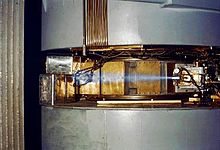|
Ionized-air glow
    Ionized-air glow is the luminescent emission of characteristic blue–purple–violet light, often of a color called electric blue, by air subjected to an energy flux either directly or indirectly from solar radiation.[1] ProcessesWhen energy is deposited in air, the air molecules become excited. As air is composed primarily of nitrogen and oxygen, excited N2 and O2 molecules are produced. These can react with other molecules, forming mainly ozone and nitrogen(II) oxide. Water vapor, when present, may also play a role; its presence is characterized by the hydrogen emission lines. The reactive species present in the plasma can readily react with other chemicals present in the air or on nearby surfaces. Deexcitation of nitrogenThe excited nitrogen deexcites primarily by emission of a photon, with emission lines in ultraviolet, visible, and infrared band:
The blue light observed is produced primarily by this process.[2] The spectrum is dominated by lines of single-ionized nitrogen, with presence of neutral nitrogen lines. Deexcitation of oxygenThe excited state of oxygen is somewhat more stable than nitrogen. While deexcitation can occur by emission of photons, the more probable mechanism at atmospheric pressure is a chemical reaction with other oxygen molecules, forming ozone:[2]
This reaction is responsible for the production of ozone in the vicinity of strongly radioactive materials and electrical discharges. OccurrenceExcitation energy can be deposited in air by a number of different mechanisms:

ColorsIn dry air, the color of produced light (e.g. by lightning) is dominated by the emission lines of nitrogen, yielding the spectrum with primarily blue emission lines. The lines of neutral nitrogen (NI), neutral oxygen (OI), singly ionized nitrogen (NII) and singly ionized oxygen (OII) are the most prominent features of a lightning emission spectrum.[13] Neutral nitrogen radiates primarily at one line in the red part of the spectrum. Ionized nitrogen radiates primarily as a set of lines in the blue part of the spectrum.[14] A violet hue can occur when the spectrum contains emission lines of atomic hydrogen. This may happen when the air contains high amount of water, e.g. with lightnings in low altitudes passing through rain thunderstorms. Water vapor and small water droplets ionize and dissociate easier than large droplets, therefore have higher impact on color.[citation needed] The hydrogen emission lines at 656.3 nm (the strong H-alpha line) and at 486.1 nm (H-beta) are characteristic for lightnings.[15] Rydberg atoms, generated by low-frequency lightnings, emit at red to orange color and can give the lightning a yellowish to greenish tint.(confusing?)[citation needed] Generally, the radiant species present in atmospheric plasma are N2, N2+, O2, NO (in dry air) and OH (in humid air). The temperature, electron density, and electron temperature of the plasma can be inferred from the distribution of rotational lines of these species. At higher temperatures, atomic emission lines of N and O, and (in presence of water) H, are present. Other molecular lines, e.g. CO and CN, mark the presence of contaminants in the air.[16] Cherenkov radiationThe emission of blue light is often attributed to Cherenkov radiation.[8][verification needed] Cherenkov radiation is produced by charged particles which are traveling through a dielectric substance at a speed greater than the speed of light in that medium. Despite the production of similarity-colored light and an association with high-energy particles, Cherenkov radiation is generated by a fundamentally different mechanism.[citation needed] See alsoReferences
|


